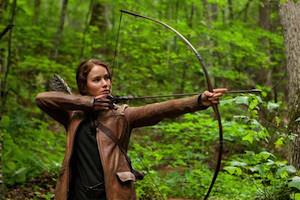Hey Hollywood, Remember the Ladies?
A new study demonstrates that women are featured less and hypersexualized more than men in film. So although Jennifer Lawrence may have captured everyone’s imagination playing heroine Katniss Everdeen in "The Hunger Games," that feat remains the exception rather than the rule. A new study demonstrates that women are featured less and hypersexualized more than men in film.
Appearances are everything in Hollywood, but even recent female-led blockbusters such as “The Hunger Games,” the “Twilight” franchise and “Bridesmaids” — movies held up to dispel notions of a gender imbalance in the industry — aren’t enough to disguise the sobering reality that Hollywood is still very much dominated by men.
A newly released USC Annenberg School for Communication and Journalism study found that female representation in popular films in 2012 was the lowest it’s been in the last five years. Researchers discovered that in 2012, women made up a paltry 28.4 percent of featured speaking roles in Hollywood’s 100 most popular films, a nearly 5 percent drop from three years ago. To put that dismal figure in perspective, that’s one woman per every 2.51 men. And it’s not as if women suddenly disappeared from the big screen; that number has stayed relatively stagnant over the last five years, even as more attention has been drawn to the disparity between genders in the movie industry.
To see how Hollywood favors men, take a look at some of the movies that are most anticipated to be hits this summer. “Iron Man 3,” “The Great Gatsby,” “The Hangover Part III,” “Man of Steel,” “The Lone Ranger” and “The Wolverine” all have one thing in common: They feature male actors in the leading role. So although Jennifer Lawrence may have captured everyone’s imagination playing heroine Katniss Everdeen in “The Hunger Games,” that feat remains the exception rather than the rule in Hollywood.
“Jennifer Lawrence in ‘The Hunger Games’ is a bit of an anomaly,” said Stacy L. Smith, a professor at Annenberg and the study’s principal investigator, noting that in 2007, only 20 percent of the top 100 grossing films featured a female lead or co-star. “We didn’t measure female leads specifically for this project, and there may be some variation across other years, but our sense is that the 2007 numbers have remained fairly consistent,” she added.
What’s more, women in film are also more likely to be sexualized than men, something that shouldn’t come as a surprise if you’ve been to the movies lately (hello, “Spring Breakers”). The USC researchers discovered that 31.6 percent of women portrayed in the top-grossing films of 2012 were dressed in sexy attire or shown partially nude. Let’s face it: Sex sells. And as long as T&A can titillate audiences enough to make them want to buy movie tickets, then the billion-dollar film industry will continue to objectify women, repercussions be darned.
But here’s something truly disturbing: Hollywood’s hypersexualized portrayal of women who are only a few years removed from puberty. The study revealed that 56.6 percent of female teens in the top 2012 films were dressed in provocative clothing, while 55.8 percent were shown partially or fully nude. This is problematic because studies have demonstrated that such depictions can negatively impact female viewers.
Although the Annenberg study doesn’t directly address those effects, Smith notes that other researchers have examined the issue. “The literature reveals that exposure to objectifying images of women may increase body shame, appearance anxiety and other negative effects among some viewers,” she said.
The silver lining of the Annenberg report is that women are featured more — and hypersexualized less — when behind the scenes positions in writing, directing or producing are filled by women. Yet, despite this positive impact, the researchers found that male filmmakers outnumbered female ones last year 5-to-1.
“This study adds to a growing body of evidence that suggests that the individuals behind the camera may play a role in what we see on screen,” said Smith, who also conducted a study this year that looked at female filmmakers in independent and major studio movies. She noted that the biggest finding of the new study is an association between having a woman behind the lens and less female sexualization.
“This is notable to us because of the growing concern over the potential negative effects on female viewers due to sexualizing or objectifying portrayals of women on screen,” she said.
So how to change the situation? Another of the new study’s researchers, Katherine Pieper, says it would be informative to discuss the topic with filmmakers because they “could potentially shed light on these decisions and whether they are made thoughtfully or spontaneously. Individual choices may seem inconsequential, but in the aggregate, they could make a powerful statement.”
USC researcher Marc Choueiti says the best way to improve these matters is to offer actresses parts big and small. “The gender balance of a film takes into account women in primary roles, as well as smaller parts,” he explained.
Smith offered another solution: Make more movies that tell women’s stories. “The success of some female-led films, like ‘The Hunger Games,’ is due to having a great story and a great team of content creators, like [‘Games’] producer Nina Jacobson,” she said. “If Hollywood really wants to help women, the first step is to greenlight great stories with female protagonists.”
Your support matters…Independent journalism is under threat and overshadowed by heavily funded mainstream media.
You can help level the playing field. Become a member.
Your tax-deductible contribution keeps us digging beneath the headlines to give you thought-provoking, investigative reporting and analysis that unearths what's really happening- without compromise.
Give today to support our courageous, independent journalists.






You need to be a supporter to comment.
There are currently no responses to this article.
Be the first to respond.